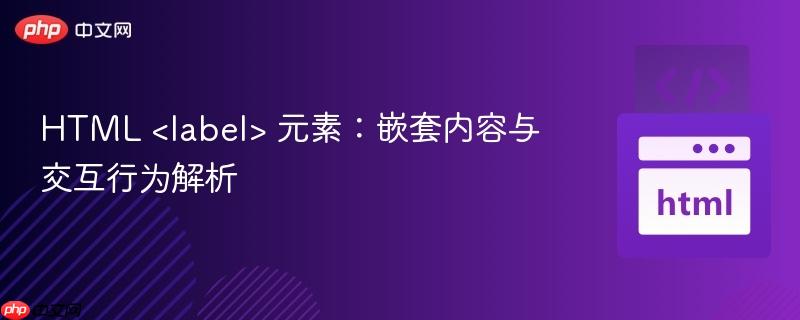 元素:嵌套内容与交互行为解析
" />
元素:嵌套内容与交互行为解析
" />
html中的`
<label> 元素是 HTML 中用于提高表单可访问性和用户体验的关键组件。它的主要作用是将文本标签与表单控件关联起来,从而:
<label> 与表单控件的关联方式主要有两种:
<label for="username">用户名:</label> <input type="text" id="username">
<label> <input type="checkbox" name="agree"> 我同意服务条款 </label>
<label> 元素属于“短语内容”(Phrasing Content)类别,这意味着它通常可以包含其他短语内容,例如文本、<span>、<img> 以及某些表单控件。重要的是,<label> 元素可以包含多个子元素,包括多个表单控件。
根据 W3C 规范和 MDN 文档,能够被 <label> 元素“标记”(labeled control)的表单控件包括:
立即学习“前端免费学习笔记(深入)”;
针对在 <label> 内部同时放置复选框 (<input type="checkbox">) 和隐藏输入字段 (<input type="hidden">) 的情况,我们可以明确以下几点:
结构上的合法性: 在 <label> 元素内部嵌套一个复选框和一个隐藏输入字段,从 HTML 结构上来说是完全合法的。<label> 元素可以作为这些元素的容器。
<label class="product">
<input class="product-checkbox" name="product1" type="checkbox">
<input type="hidden" name="product1-information" value="{...}" />
<span class="product-name">产品1</span>
</label>交互行为:
考虑以下产品选择列表的场景:
<!DOCTYPE html>
<html lang="zh-CN">
<head>
<meta charset="UTF-8">
<meta name="viewport" content="width=device-width, initial-scale=1.0">
<title>产品选择示例</title>
<style>
.product-list {
list-style: none;
padding: 0;
}
.product-item {
margin-bottom: 10px;
border: 1px solid #eee;
padding: 10px;
cursor: pointer; /* 提示用户这是一个可点击区域 */
display: block; /* 使label占据整行,方便点击 */
}
.product-item:hover {
background-color: #f9f9f9;
}
.product-name {
margin-left: 8px;
font-weight: bold;
}
</style>
</head>
<body>
<h1>选择您的产品</h1>
<ul class="product-list">
<li>
<label class="product-item">
<input class="product-checkbox" name="product1" type="checkbox" value="prod_a">
<input type="hidden" name="product1-info" value='{"id": "A001", "price": 19.99, "category": "Electronics"}' />
<span class="product-name">智能手表 X1</span>
</label>
</li>
<li>
<label class="product-item">
<input class="product-checkbox" name="product2" type="checkbox" value="prod_b">
<input type="hidden" name="product2-info" value='{"id": "B002", "price": 9.99, "category": "Accessories"}' />
<span class="product-name">无线耳机 Pro</span>
</label>
</li>
<li>
<label class="product-item">
<input class="product-checkbox" name="product3" type="checkbox" value="prod_c">
<input type="hidden" name="product3-info" value='{"id": "C003", "price": 49.99, "category": "HomeAppliance"}' />
<span class="product-name">智能灯泡套装</span>
</label>
</li>
</ul>
<button onclick="submitSelection()">提交选择</button>
<script>
function submitSelection() {
const checkboxes = document.querySelectorAll('.product-checkbox:checked');
const selectedProducts = [];
checkboxes.forEach(checkbox => {
const label = checkbox.closest('label');
const hiddenInput = label.querySelector('input[type="hidden"]');
if (hiddenInput) {
selectedProducts.push({
name: label.querySelector('.product-name').textContent,
value: checkbox.value,
info: JSON.parse(hiddenInput.value)
});
}
});
console.log("已选择的产品:", selectedProducts);
alert("请查看控制台输出以获取已选择的产品信息。");
}
</script>
</body>
</html>在这个示例中:
这种结构是完全有效且符合标准的。它利用了 <label> 元素的可点击区域优势,同时允许在视觉上与复选框关联的同一逻辑单元内存储非交互性数据。
将复选框和隐藏输入字段嵌套在同一个 <label> 元素中是符合 HTML 规范的有效做法。其核心要点在于:
这种灵活的结构在需要将用户选择与相关联的非交互性数据在语义和结构上进行捆绑时非常有用,尤其是在处理动态生成或复杂表单时。
以上就是HTML 元素:嵌套内容与交互行为解析的详细内容,更多请关注php中文网其它相关文章!

HTML怎么学习?HTML怎么入门?HTML在哪学?HTML怎么学才快?不用担心,这里为大家提供了HTML速学教程(入门课程),有需要的小伙伴保存下载就能学习啦!




Copyright 2014-2025 https://www.php.cn/ All Rights Reserved | php.cn | 湘ICP备2023035733号